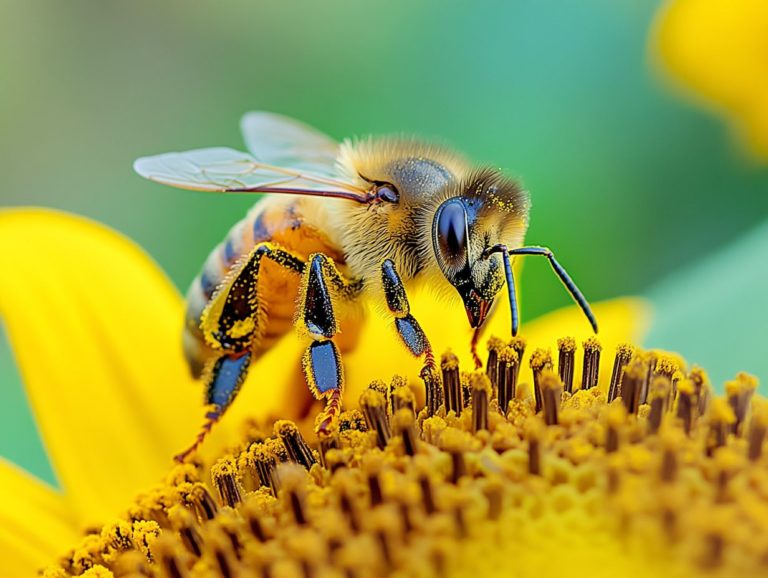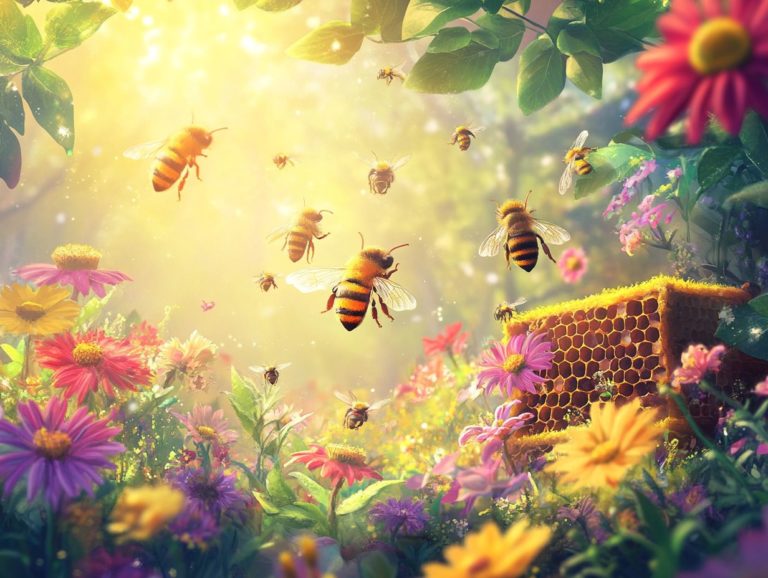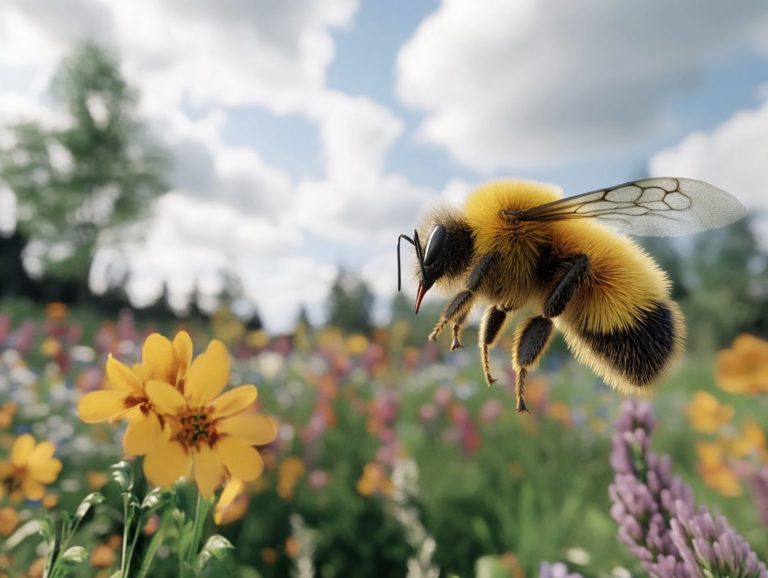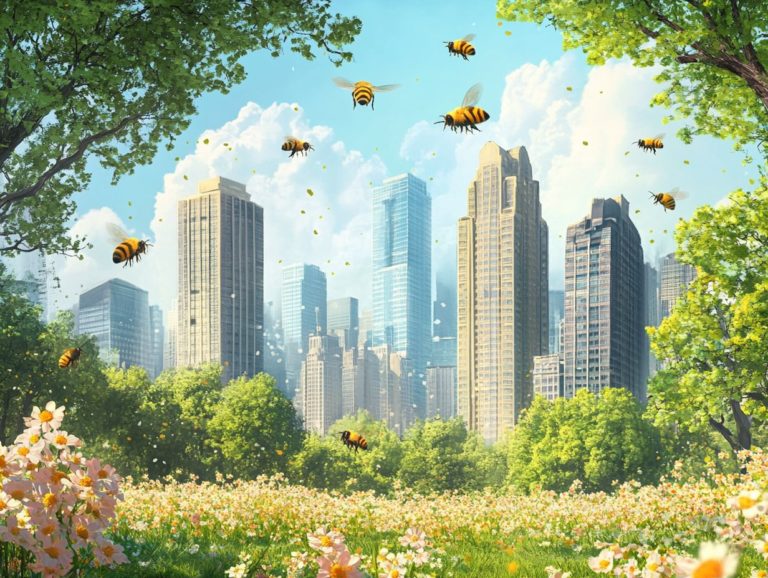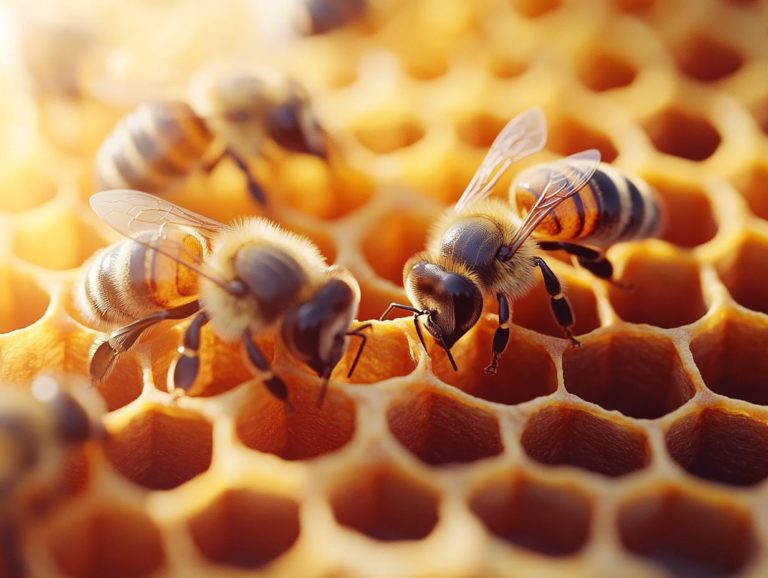The Influence of Light on Bee Activity
Light is essential to the lives of bees, guiding their navigation and foraging behavior in profound ways. The subtleties of light influence their circadian rhythms and overall health. This plays a pivotal role in shaping their immune responses and reproductive success. This is particularly significant for species like Andrenidae, Colletidae, and Halictidae.
As artificial lighting and light pollution continue to rise, understanding how these elements affect bees becomes increasingly vital. This includes grasping the minimum light levels necessary for nocturnal insects and the role of dim light in their lives.
Discover how bees interact with light and learn essential strategies for sustainable beekeeping in this exciting article!
Contents
Key Takeaways:
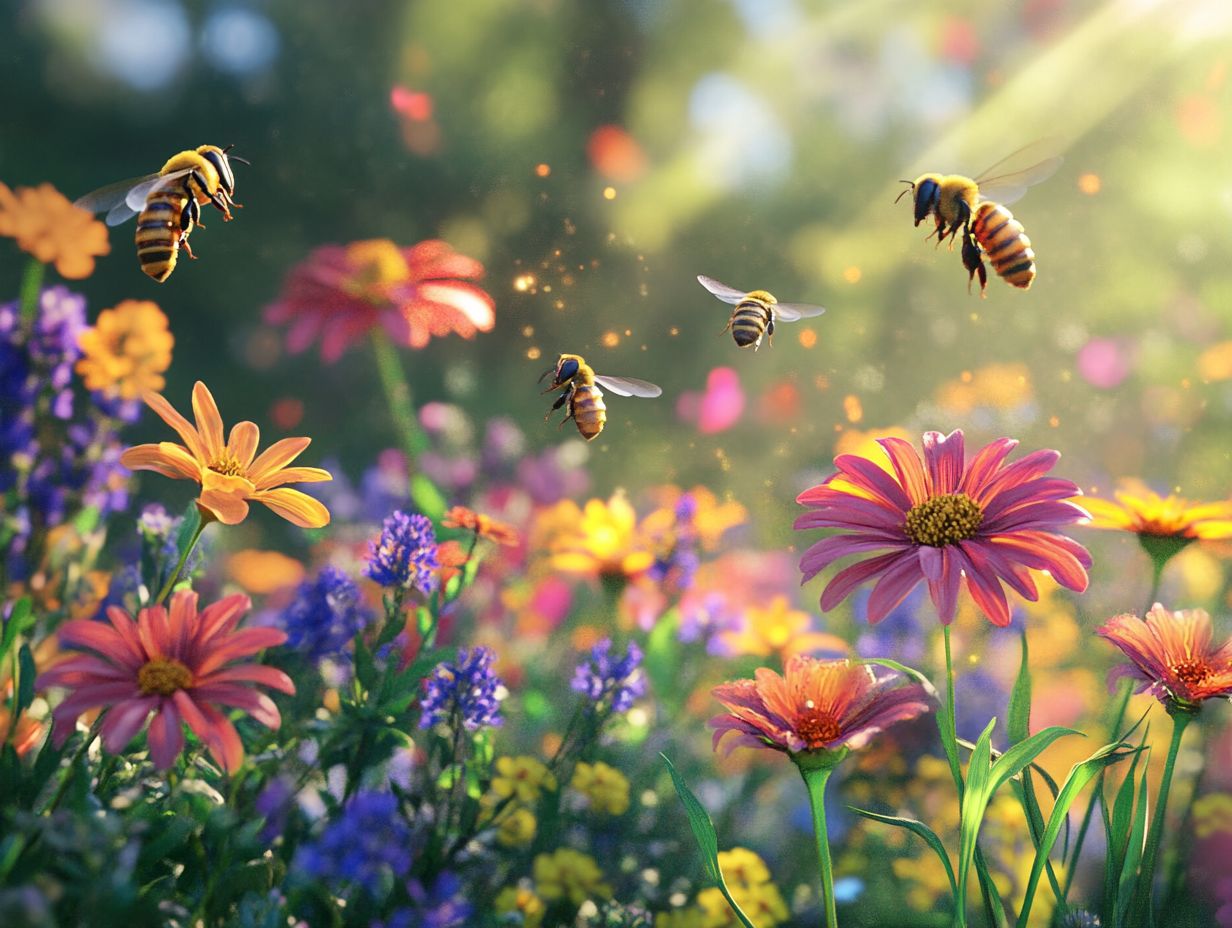
- Light plays a crucial role in bee navigation and affects their circadian rhythms, foraging behavior, immune system, and reproduction. This impacts both diurnal and nocturnal bees.
- Artificial light at night and light pollution can harm bee behavior and health, but there are ways to mitigate these effects.
- Sustainable beekeeping practices involve using light to improve honey production and promoting healthy bee populations through proper light management, especially for species in the Apidae and Myrtaceae families.
How Do Bees Respond to Light?
Bees demonstrate a fascinating and intricate response to light that significantly influences their foraging behaviors and overall activity levels. This is especially true for nocturnal species like Megalopta, which are uniquely adapted to excel in low-light conditions.
Understanding the interplay between light intensity and environmental factors such as temperature, humidity, and wind speed sheds light on flower availability and visitation patterns. This is essential for grasping their ecological needs and evolutionary adaptations, particularly in ecosystems like the Atlantic Forest in Brazil. Here, species like Campomanesia phaea (cambuci) from the Myrtaceae family thrive.
The twilight period, in particular, serves as a transitional phase. During this time, both diurnal and nocturnal bees ramp up their activities, underscoring the critical role that light plays in their daily existence.
Light plays a pivotal role in the navigation of bees, especially those within the Apidae family. It influences their remarkable ability to find flowers and return to their hives.
These extraordinary insects utilize various light cues, heavily relying on the orientation of polarized light from the sky. Essentially, polarized light is sunlight that has been scattered in a specific direction, providing them with invaluable information about their surroundings. This adaptation is vital for their daytime foraging, as it helps them determine the position of the sun, even when it s shrouded by clouds. Such capabilities are especially notable in Apidae and other related families.
When it comes to nocturnal foraging, bees employ distinct navigation strategies. They use moonlight and celestial markings to chart their course. This impressive versatility in leveraging both diurnal and nocturnal cues ensures that bees can navigate their environment with remarkable efficiency. This maximizes their foraging efforts, regardless of the hour. Noteworthy examples include species like Xylocopa tranquebarica and Ptiloglossa.
As you consider these fascinating insights, think about how you can implement light management practices in your local beekeeping efforts. Share this article with fellow bee enthusiasts to spread awareness!
How Does Light Affect Bees’ Circadian Rhythms?
Light plays a critical role in shaping the circadian rhythms of bees, determining their activity patterns and foraging behaviors from dawn to dusk. The twilight period acts as a crucial transitional phase that affects their behaviors.
This fascinating connection between light and how bee bodies work influences their internal clocks. As daylight waxes and wanes, you ll notice bees engaging in specific activities, such as foraging for nectar or pollen, all heavily influenced by the intensity of light.
For example, on those cloudy days when the light is less vibrant, bees tend to hold off on foraging. Instead, they choose to stay within the hive to maintain social cohesion and safeguard their colony’s resources.
External environmental factors like temperature and humidity also influence these schedules. This creates a complex tapestry that ensures their survival and productivity.
By understanding these patterns, you not only gain insight into their daily routines but also recognize the critical need to preserve natural habitats that support thriving bee populations.
How Does Light Impact Bees’ Foraging Behavior?
The impact of light on foraging behavior can be profound, as the availability of flowers often aligns with specific light conditions. This shapes the visitation patterns of both diurnal and nocturnal bees. Flower abundance and the moon phase are critical factors too.
For example, diurnal species like honeybees are most active during daylight hours, eagerly seeking out blooms when sunlight enhances the visibility of their favorite nectar sources. This surge in activity boosts their foraging efficiency and elevates pollination success, as they transfer pollen between flowers more frequently.
On the flip side, nocturnal pollinators, including some moths and specific night-active bees, skillfully navigate by moonlight to locate flowers that release stronger fragrances in the dark. This adaptation enables them to tap into resources that diurnal species might overlook, creating a vibrant pollination ecosystem where different species complement one another based on available light levels.
The Importance of Light for Bee Health
Light is crucial for maintaining bee health, significantly impacting various physiological processes. These include the immune system, reproductive success, and their resilience against pests and diseases. Recognizing the importance of proper lighting conditions is crucial for protecting these amazing pollinators.
How Does Light Affect Bees’ Immune System?
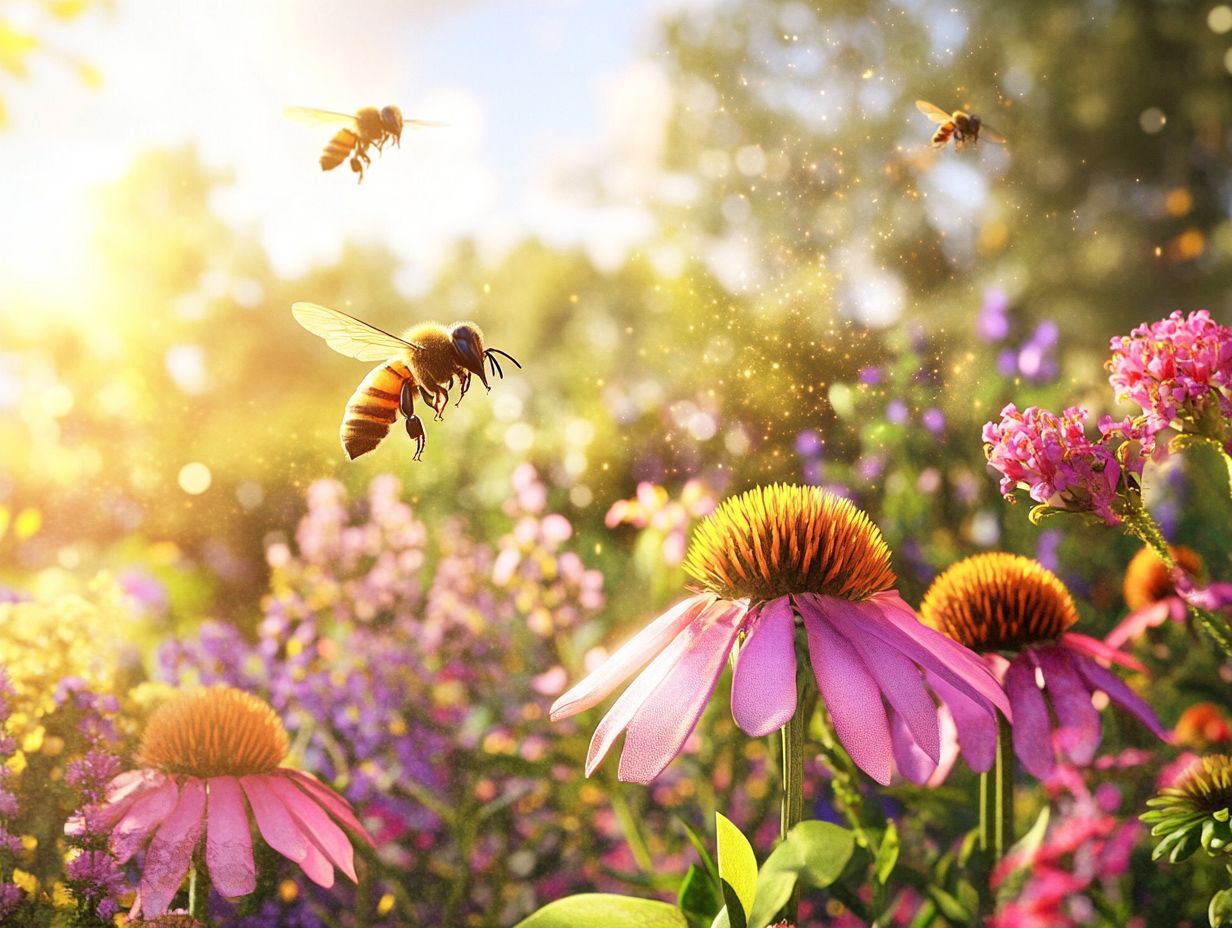
Research shows that light exposure can significantly impact the immune system of bees, affecting their ability to fend off pathogens and maintain overall health.
The delicate balance between light and hive vitality reveals that bees, much like other organisms, are attuned to the quality and quantity of light they receive. This exposure can modulate their biological rhythms and hormone levels, ultimately influencing their immune responses.
For example, certain wavelengths of light, particularly ultraviolet light, may trigger the production of antimicrobial peptides, bolstering their disease resistance. Environmental factors such as habitat quality and forage availability can further shape the connection between light and immunity.
This underscores the importance of adopting a holistic view when considering bee health. It s essential to take into account both stress factors in their environment and the vital role of natural light cycles.
What Are the Effects of Light on Bees’ Reproduction?
Light affects both day and night bees. Changes in daylight and artificial light can disrupt their natural cycles.
Light exposure plays a crucial role in the reproductive success of bees, especially for honey bee queens (Apis mellifera). It influences their mating behavior and egg-laying patterns in profound ways.
This relationship between light and reproduction is essential for both diurnal and nocturnal species. Fluctuations in daylight hours and the presence of artificial light can disturb their natural rhythms. For example, if the environmental light is inconsistent, queens may find their mating flights altered, which can lead to decreased mating success and ultimately a reduction in the number of eggs laid.
Such disruptions can have significant consequences for overall hive populations, particularly during seasonal transitions. Factors like temperature and habitat also play vital roles in hive health and productivity. This creates a complex interplay that can impact bee communities on various levels.
Can Light Exposure Help Control Pests and Diseases in Beehives?
The potential for using light exposure to control pests and diseases in beehives is an exciting frontier in research, hinting that specific colors of light might actually deter harmful insects and pathogens.
As you delve into the effects of various light treatments, you ll uncover remarkable insights into how colored light and its intensity can influence bee health and the dynamics within the hive. You re encouraged to consider these findings in your management practices, which could lead to innovative strategies that reduce your reliance on chemical interventions.
By thoughtfully integrating controlled light exposure into your hive care routines, you could significantly bolster the resilience of your colonies. This not only supports the well-being of the bees but also enhances the overall productivity of your honey harvesting efforts.
Exploring this field offers exciting possibilities for practical solutions, providing you with exciting, eco-friendly solutions that can change your beekeeping game!
How Artificial Light is Changing Bee Behavior
Artificial light significantly influences bee behavior, disrupting their natural foraging patterns, communication methods, and hive dynamics. This raises important concerns about the effects of light pollution on bee populations and their ecological needs.
How Does Artificial Light at Night Affect Bees’ Behavior?
Artificial light at night has a profound impact on bee behavior, particularly affecting their foraging patterns and social interactions within the hive.
This disruption presents significant challenges not only for diurnal species such as Apis mellifera that depend on daylight cues for navigation and flower availability, but also for nocturnal species that have adapted over time to thrive in low-light conditions and dim light.
Studies indicate that the introduction of artificial illumination can bewilder these essential pollinators, resulting in a decreased flower visitation, misaligned foraging times, and reduced reproductive success for the plants that rely on them for pollination.
For instance, research conducted in urban environments like the Atlantic Forest in Brazil has shown that bees exposed to bright streetlights experienced a 30% decline in foraging efficiency, thus disrupting the delicate balance of local ecosystems. The consequences of these behavioral shifts extend beyond the bees themselves, potentially affecting plant communities such as Myrtaceae, food webs, and the overall health of the environment.
What Are the Consequences of Light Pollution on Bees?
Light pollution presents significant challenges for bee populations, including nocturnal bees and families such as Apidae, Andrenidae, Colletidae, and Halictidae. It disrupts their ecological needs and undermines their crucial roles in pollination by species like Xylocopa tranquebarica and Megalopta. This also threatens biodiversity.
The introduction of artificial light alters natural activity patterns, causing a misalignment with plants that rely on specific light cues to bloom. This disruption can lead to reduced reproductive success, as bees may find it difficult to locate food sources or navigate their surroundings effectively.
Constant illumination of urban landscapes can interfere with bees’ circadian rhythms. This creates stress that ultimately impacts their health and survival. Circadian rhythms are the internal clocks that regulate their daily activities.
Acting on these issues is crucial for saving our bees! Advocating for the preservation of natural light environments and considering minimum light levels helps maintain the delicate balance of ecosystems that countless species, including bees, rely on for survival.
How Can We Mitigate the Negative Effects of Artificial Light on Bees?
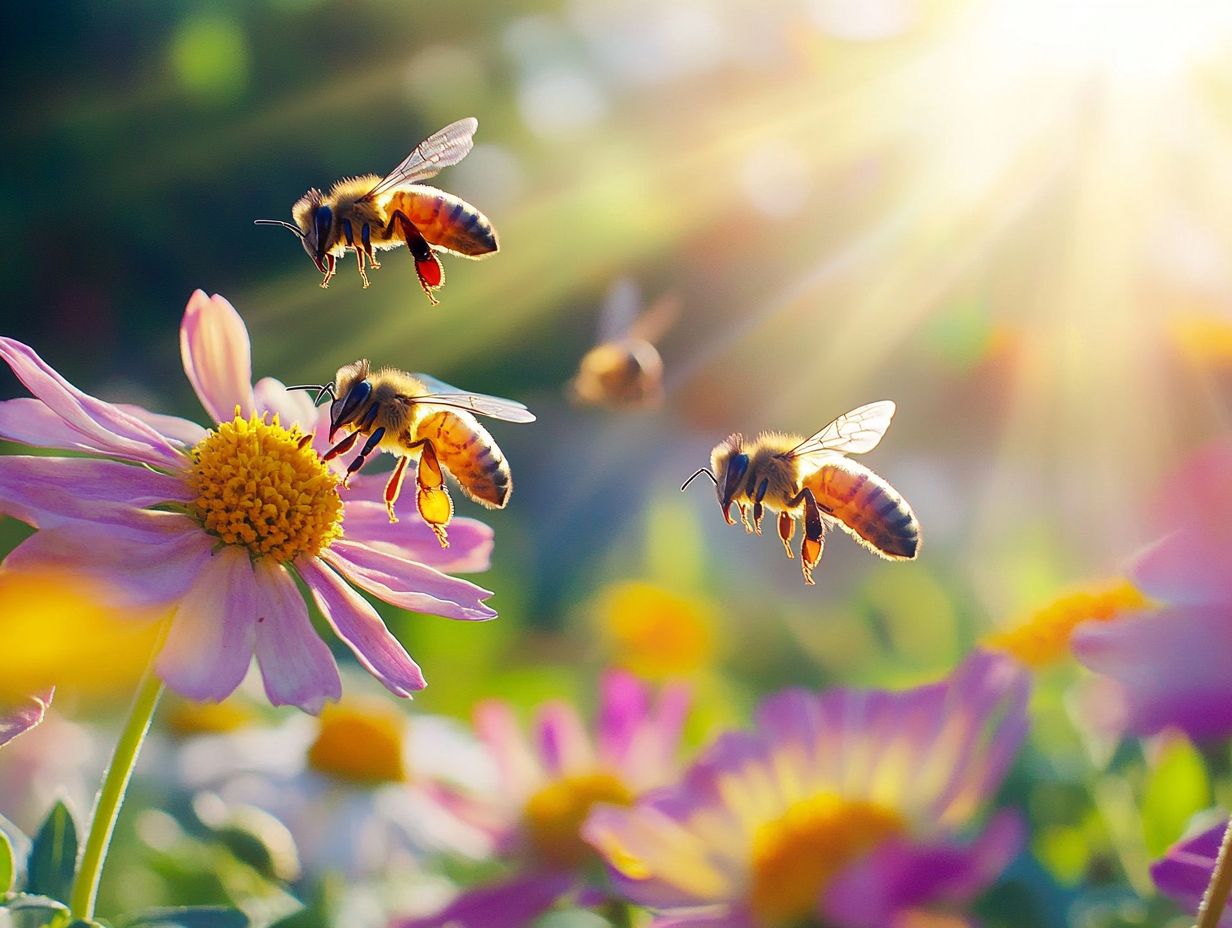
Reducing the harm caused by artificial light on bees requires strategic actions that promote ecological balance and support their natural behaviors and ecological requirements for species like Ptiloglossa and Zikanapis seabrai.
One effective approach is reevaluating your current lighting designs, considering light intensity. Opt for less intrusive options that minimize illumination during critical foraging times and the twilight period. By choosing warmer, lower-intensity lights and implementing timers or motion sensors, you can significantly reduce light pollution in areas frequented by these essential pollinators.
Encouraging the creation of dark habitats with flower abundance, such as bee-friendly gardens, can greatly enhance their well-being. These gardens provide shelter and food while minimizing bright exposure, which is vital for the egg-laying activities of honey bee queens.
Raising public awareness about the ecological needs of bees through community workshops and educational campaigns focused on environmental factors, such as temperature, humidity, and wind speed, is crucial in building support for these initiatives. Working together can protect our precious bee populations!
This collaborative effort not only aids in protecting bee populations but also enhances overall biodiversity, enriching the environment for everyone involved.
The Role of Light in Sustainable Beekeeping
Light is a crucial factor in sustainable beekeeping, affecting honey production, bee health, and management practices that bolster the resilience of bee populations. Understanding how light influences these aspects empowers you to create a thriving environment for your bees and optimize their productivity.
How Can Beekeepers Use Light to Improve Honey Production?
You can harness the power of light to elevate honey production by optimizing foraging conditions and influencing bee activity during critical periods.
To make the most of light dynamics, consider natural sunlight patterns when positioning your hives. Ensuring that your colonies bask in ample morning light can significantly stimulate their foraging behavior. It’s also essential to understand the relationship between temperature and humidity. Warmer, drier conditions tend to motivate bees to be more active, which translates to increased nectar collection.
Think about incorporating reflective materials around your hives. This simple tactic can enhance natural light exposure while helping to regulate temperature. In certain situations, you might want to use artificial lighting during darker months or in shaded spots to effectively simulate ideal conditions for your bees to flourish and produce honey efficiently.
What Are the Best Practices for Managing Light in Beekeeping Operations?
Implementing best practices for managing light in your beekeeping operations can significantly elevate bee health and productivity, fostering a thriving hive environment.
By thoughtfully considering both the amount and quality of light that enters the hive, you can cultivate an atmosphere that encourages optimal activity levels during periods of stable temperature and humidity among your bees. For example, creating shaded areas during the hottest parts of the day can help stave off heat stress, while strategically positioned reflective surfaces and reflective materials can maximize natural light during the cooler months. These adjustments not only influence foraging behavior but also bolster the overall vitality of your colony.
The interaction of light with the hive and its surroundings can shape the rhythms of your bees, affect their communication methods, and enhance their ability to adapt to seasonal changes due to evolution.
How Can We Promote Healthy Bee Populations through Proper Use of Light?
Promoting healthy bee populations through the thoughtful use of light means implementing sustainable strategies that honor their natural behaviors and ecological requirements.
Consider establishing native flower gardens with Campomanesia phaea (cambuci) that bloom throughout the seasons, ensuring bees have a reliable food source all year round. By managing artificial lighting around apiaries and agricultural areas, you can minimize disruptions that confuse and disorient these essential pollinators.
Educating the public about the importance of dark spaces for nocturnal insects like nocturnal bees for foraging activities encourages a community-centered approach to protecting not just bees, but the broader ecosystem as well. By emphasizing the significance of maintaining a balanced light environment, you contribute to enhanced pollination efforts, supporting biodiversity and promoting overall environmental health and the role of bee activity.
Frequently Asked Questions
What is the influence of light on bee activity?
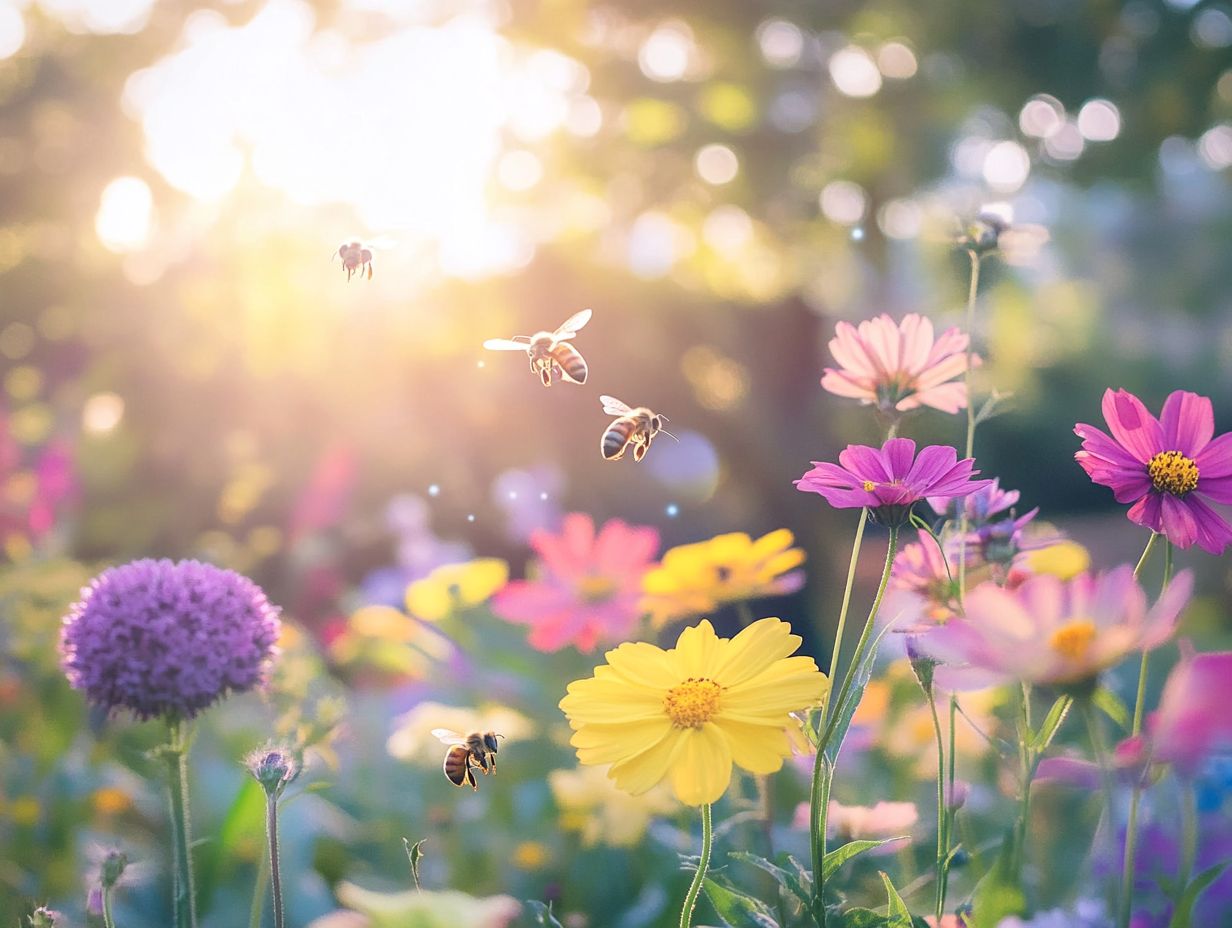
The influence of light on bee activity refers to how light affects the behavior and movement of bees. It can impact their foraging patterns, navigation, and overall productivity.
How does light affect bee foraging?
Light plays a crucial role in bee foraging as it helps bees locate flowers and navigate back to their hive. Different wavelengths of light can also attract or repel bees, affecting their foraging preferences.
Can light pollution affect bee activity?
Yes, light pollution can have a negative impact on bee activity. Artificial light at night can disrupt their circadian rhythm, leading to decreased foraging and navigation abilities.
Are certain types of light more beneficial for bees?
Bees are most attracted to blue and violet light, which are the colors commonly found in flowers. Red and yellow lights are less attractive to bees.
How does light impact bee communication?
Light can affect bee communication by interfering with their ability to see and interpret visual cues, such as dance movements, that they use to communicate with each other.
Can changes in light affect bee colonies?
Yes, changes in light can have a significant impact on bee colonies. For example, sudden changes in natural light patterns due to weather or artificial light sources can cause stress and disrupt their social hierarchy.

